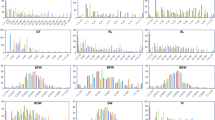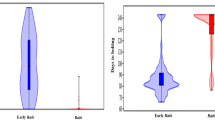Abstract
Grain dormancy is an important component of resistance to preharvest sprouting in wheat. Historically, red grain coat colour has been associated with this trait despite clear evidence of wide variation in dormancy amongst both red and white wheat varieties. Whereas the genes controlling red grain coat colour have been identified, the mechanism involved in their effect on dormancy has not been determined. This investigation confirmed that the R gene that controls colour in a single gene (Tamyb10-A1b) red wheat, AUS1490 is a Tamyb10 transcription factor. Mutation of Tamyb10-A1 resulted in a white grain coat as well as a reduction in dormancy that was manifest as an early release from dormancy during grain ripening. Red coat colour per se appeared to increase the time to dormancy release and had a cumulative effect in combination with other dormancy loci that are not linked to grain colour. In quantitative terms, the effect of the seed coat colour appeared to be equivalent to that of the dormancy loci present in AUS1490 that are not linked to grain colour. Dormancy release occurred earlier in isolated embryos compared with intact caryopses but was similar in both the mutants and the parental line. This suggests that a component of dormancy that is not associated with the red coat colour is expressed in the embryo and that it interacts with factors in the grain coat to generate the phenotype of the intact caryopsis.





Similar content being viewed by others
Code availability
Not applicable.
References
Flintham JE (2000) Different genetic components control coat-imposed and embryo-imposed dormancy in wheat. Seed Sci Res 10:43–50
Gale MD, Atkinson MD, Chinoy CN, Harcourt RL, Jia J, Li QY, Devos KM (1995) Genetic maps of hexaploid wheat. In: Li ZS, Xin XY (eds) Proceedings of the eighth international wheat genetics symposium. China Agricultural Scientech Press, Beijing
Gergets T, Scholefield D, Foulkes MJ, Lenton JR, Holdsworth MJ (2010) An analysis of dormancy, ABA responsiveness, after-ripening and pre-harvest sprouting in wheat (Triticum aestivum L.) caryopses. J Exp Bot 61:597–607. https://doi.org/10.1093/jxb/erp329
Groos C, Gay G, Perretant M-R, Gervais L, Bernard M, Dedrver F, Charmet G (2002) Study of the relationship between pre-harvest sprouting and grain colour by quantitative trait loci analysis in a white x red grain bread-wheat cross. Theor Appl Genet 104:39–47
Himi E, Noda K (2004) Isolation and location of three homologous dihydroflavonol-4-reductase (DFR) genes of wheat and their tissue-dependent expression. J Exp Bot 55:365–375. https://doi.org/10.1093/jxb/erh046
Himi E, Nisar A, Noda K (2005) Colour genes (R and Rc) for grain and coleoptile upregulate flavonoid biosynthesis genes in wheat. Genome 48: 747–754. 10.1139/G05-026
Himi E, Maekawa M, Miura H, Noda K (2011) Development of PCR markers for Tamyb10 related to R-1 red grain color in wheat. Theor Appl Genet 122:1561–1576
Himi E, Maekawa M, Matsuura T, Taketa S (2015) Real-time PCR-mediated diagnosis of heterozygosity at the Tamyb10-D1 locus controlling grain colour in wheat. Mol Breeding 35:90. https://doi.org/10.1007/s11032-015-0251-3
Jia L, Clegg MT, Jiang T (2004) Evolutionary dynamics of the DNA-binding domains in putative R2R3-MYB genes identified from rice subspecies indica and japonica genomes. Plant Physiol 134:575–585. https://doi.org/10.1104/pp.103.027201
Kohyama N, Chono M, Nakagawa H, Matsuo Y, Ono H, Matsunaka H (2017) Flavonoid compounds related to seed coat color of wheat. Biosci Biotech Biochem 81:2112–2118. https://doi.org/10.1080/09168451.2017.1373589
Mares DJ (1983) Preservation of dormancy in freshly harvested wheat grain. Aust J Agric Res 34:33–38
Mares DJ (1984) Temperature dependence of germinability of wheat (Triticum aestivum L.) grain in relation to preharvest sprouting. Aust J Agric Res 35:115–128
Mares DJ (1999) The seed coat and dormancy in wheat grains. In: Weipert D (ed) Eighth International Symposium on Preharvest Sprouting in Cereals 1998’. Association of Cereal Research Federal Centre for Cereal Potato and Lipid Research, Detmold
Mares DJ, Mrva K (2001) Mapping quantitative trait loci associated with grain dormancy in Australian wheat. Aust J Agric Res 52:1257–1265. https://doi.org/10.1071/AR010490004-9409/01/111257
Mares DJ, Mrva K, Cheong J, Williams K, Watson B, Storlie E, Sutherland M, Zou Y (2005) A QTL located on chromosome 4A associated with dormancy in white- and red-grained wheats of diverse origin. Theor Appl Genet 111:1357–1364. https://doi.org/10.1007/s00122-005-0065-5
Mares D, Rathjen MK, Cheong J (2009) Genetic and environmental control of dormancy in white-grained wheat (Triticum aestivum L.). Euphytica 168:311–318. https://doi.org/10.1007/s10681-009-9927-2
Mares D, Mrva K, Cheong J, Fox R, Mather D (2021) Dormancy and dormancy release in white-grained wheat (Triticum aestivum L). Planta 253:5. https://doi.org/10.1007/s00425-020-03518-8
Noda K, Matsuura T, Maekawa M, Taketa S (2002) Chromosomes responsible for sensitivity of embryo to abscisic acid and dormancy in wheat. Euphytica 123:203–209
Ogata K, Morikawa S, Nakamura H, Sarai A, Ishii S, Nishimura Y, Nakamura H (1994) Solution structure of a specific DNA complex of Myb DNA-binding domain with cooperative recognition helices. Cell 79:639–648
Pallotta MA, Graham RD, Langridge P, Sparrow DHB, Barker SJ (2000) RFLP mapping of manganese efficiency in barley. Theor Appl Genet 96:435–446
Rogowsky PM, Guidet FLY, Langridge P, Sheperd KW, Koebner RMD (1991) Isolation and characterisation of wheat-rye recombinants involving chromosome arm 1DS of wheat. Theor Appl Genet 82:537–544
Shorinola O, Balcárková B, Hyles J, Tibbits JFG, Hayden MJ, Holušova K, Valárik M, Distekfeld A, Torada A, Barrero JM, Uauy C (2017) Haplotype analysis of the pre-harvest sprouting resistance locus PHS-A1 reveals a causal role of TaMKK3-A in global germplasm. Front Plant Sci 8:1555. https://doi.org/10.3389/fpls.2017.01555
Torada A, Ikeguchi S, Koike M (2005) Mapping and validation of PCR-based markers associated with a major QTL for seed dormancy in wheat. Euphytica 143:251–255. https://doi.org/10.1007/s10681-005-7872-2
Torada A, Koike M, Ogawa T, Takenouchi Y, Tadamura K, Wu J, Maytsumoto T, Kawaura K, Ogihara Y (2016) A causal gene for seed dormancy on wheat chromosome 4A encodes a MAP kinase kinase. Curr Biol 26:1–6. https://doi.org/10.1016/j.cub.2016.01.063
Walker-Simmons M (1988) Enhancement of ABA responsiveness in wheat embryos by high temperature. Plant Cell Environ 11:769–775
Warner RL, Kudrna DA, Spaeth SC, Jones SS (2000) Dormancy in white-grained mutants of Chinese Spring wheat (Triticum aestivum L.). Seed Sci Res 10:51–60
Winkel-Shirley B (2001) Flavonoid biosynthesis. A colourful model for genetics, biochemistry, cell biology and biotechnology. Plant Physiol 126:485–493
Acknowledgements
Daryl Mares received financial support from the Australian Grains Research and Development Corporation. The authors would like to acknowledge the technical assistance provided by Ms Chen-Jung Hsu, Ms Hai-Yunn Law, Dr. Masahiko Maekawa and Mr. Takakazu Matsuura.
Funding
Daryl Mares received research funding from the Australian Grains Industry Research Corporation as Grant UA00130.
Author information
Authors and Affiliations
Contributions
Both authors contributed equally to the study and approved the final manuscript.
Corresponding author
Ethics declarations
Conflict of interest
The authors declare that they have no conflict of interest.
Additional information
Publisher's Note
Springer Nature remains neutral with regard to jurisdictional claims in published maps and institutional affiliations.
Rights and permissions
About this article
Cite this article
Mares, D., Himi, E. The role of TaMYB10-A1 of wheat (Triticum aestivum L.) in determining grain coat colour and dormancy phenotype. Euphytica 217, 89 (2021). https://doi.org/10.1007/s10681-021-02826-8
Received:
Accepted:
Published:
DOI: https://doi.org/10.1007/s10681-021-02826-8




